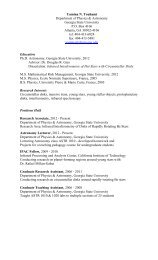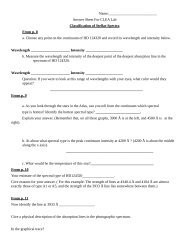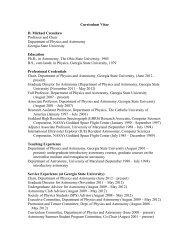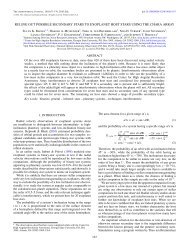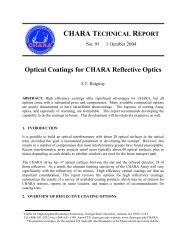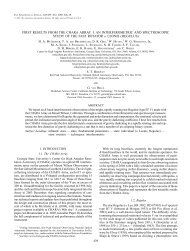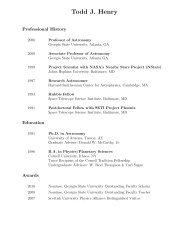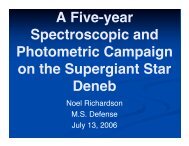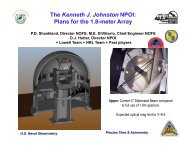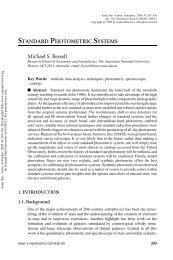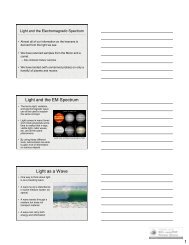syllabus: astronomy 8100 stellar structure and ... - GSU Astronomy
syllabus: astronomy 8100 stellar structure and ... - GSU Astronomy
syllabus: astronomy 8100 stellar structure and ... - GSU Astronomy
Create successful ePaper yourself
Turn your PDF publications into a flip-book with our unique Google optimized e-Paper software.
SYLLABUS: ASTRONOMY <strong>8100</strong><br />
STELLAR STRUCTURE AND EVOLUTION<br />
SPRING 2008<br />
Prof. Paul J. Wiita<br />
Timings: Mondays <strong>and</strong> Wednesdays, 10:30 AM – 12:10 PM<br />
Room: 732 One Park Place<br />
Contacts: Office: Rm. 715 One Park Place<br />
e-mail: wiita@chara.gsu.edu URL: www.chara.gsu.edu/∼wiita/teaching<br />
Phones: (404) 413-6022; home <strong>and</strong> most Fridays, (609) 273-7177<br />
Office Hours: Mondays 4:00 – 5:00 PM, Tuesdays 11:00 AM – noon, <strong>and</strong> by appointment. I<br />
have an Astr 1020 class MW 5:30 to 6:45 but am usually available at other times; however, if my<br />
office door is closed I’m out or should not be disturbed.<br />
Required Text: R. Kippenhahn & A. Weigert, Stellar Structure <strong>and</strong> Evolution<br />
Supplementary texts: Martin Schwarzschild, The Structure <strong>and</strong> Evolution of the Stars; Stuart<br />
Shapiro & Saul Teukolsky, Black Holes, White Dwarfs & Neutron Stars<br />
Other Useful Books: Ch<strong>and</strong>rasekhar, S., Stellar Structure; Clayton, Donald D., Principles of<br />
Stellar Evolution <strong>and</strong> Nucleosynthesis<br />
Course Objectives: We will study what makes stars work <strong>and</strong> change. To do so we will use many<br />
branches of physics: fluid mechanics, thermodynamics, electromagnetism <strong>and</strong> quantum mechanics<br />
are all necessary to underst<strong>and</strong> <strong>stellar</strong> <strong>structure</strong>, <strong>and</strong> some aspects of nuclear physics <strong>and</strong> general<br />
relativity are also neeeded. However, all of this material will be introduced at a rather basic level <strong>and</strong><br />
developed to the minimum extent necessary to obtain a fundamental underst<strong>and</strong>ing of the <strong>structure</strong><br />
<strong>and</strong> evolution of stars. We will stress how mass, composition <strong>and</strong> angular momentum determine<br />
the basic features of stars <strong>and</strong> determine how they are born <strong>and</strong> die. While our underst<strong>and</strong>ing of<br />
stars is far more advanced than our underst<strong>and</strong>ing of galaxies <strong>and</strong> cosmology, there are many open<br />
questions, <strong>and</strong> we shall note some of these as we go along.<br />
The main text by Kippenhahn <strong>and</strong> Weigert is quite nice, <strong>and</strong> rather comprehensive, despite<br />
being relatively thin. Its major drawback is a lack of problems. While Schwarzschild’s book is not<br />
absolutely required, it is a classic which all astronomers should have in their libraries; it has the<br />
added attraction of being quite inexpensive. The lectures will not usually follow the main text,<br />
nor will we be able to cover all of the material in the text. You are expected to read the relevant<br />
portions of the text in conjunction with the lectures. Some specific readings of material that will<br />
not be covered in class will be given as parts of your assignments.<br />
Note that this is a 4 Credit Hour course <strong>and</strong> combines what had previously been taught<br />
as two separate quarter courses on Stellar Structure (Astr 800) <strong>and</strong> Stellar Evolution (Astr 815).<br />
You should therefore expect to work somewhat harder in this course than you would in a 3 CH<br />
8000-level <strong>Astronomy</strong> course.<br />
Images of the overhead transparencies used in class will be posted to my web-site shortly<br />
after the relevant lecture. So don’t worry about copying everything that appears on them; instead,<br />
concentrate on underst<strong>and</strong>ing the material <strong>and</strong> writing down what does not appear on the overheads.
TOPIC<br />
≈ # of Lectures<br />
Review of Stellar Classification & Binary Stars 1<br />
Review of Thermodynamics & Equations of State 2<br />
Basic Equations <strong>and</strong> Numerical Techniques 2<br />
Review of Hydrostatic Equilibrium & Polytropic Models 1<br />
Nuclear Energy Generation 2<br />
Energy Transport 2<br />
Homology Relations <strong>and</strong> the Main Sequences 1<br />
Pulsating Stars 1<br />
Midterm Examination<br />
Feb 25th<br />
NO CLASSES, 3 & 5 March<br />
SPRING BREAK<br />
During qualifying exams — the week of 10 March — a class may be cancelled or postponed.<br />
Rotating Stars 1<br />
Pre-Main Sequence Evolution 2<br />
Main-Sequence Evolution & Hyashi tracks 2<br />
Post-MS Evolution to Red Giants 2<br />
Physics of White Dwarfs 1<br />
Basic General Relativity 1<br />
Dense Nuclear Matter 1<br />
Neutron Stars <strong>and</strong> Pulsars 2<br />
Student Reports; Term Papers due, April 16th 2<br />
Black Holes 2<br />
Take Home Final Exam Due<br />
Monday, April 28th, at 10:30 AM<br />
March 3rd is the last day to withdraw <strong>and</strong> still receive a grade of W.<br />
Of course, the above <strong>syllabus</strong> may be modified if necessary.<br />
GRADES will be based on performance on examinations, assignments, <strong>and</strong> projects.<br />
The take-home comprehensive final will count for 30% of your grade, while the in-class<br />
midterm (closed book <strong>and</strong> closed-notes) will comprise 20% of it. Several assignments will together<br />
account for 30%. We will take advantage of the +/− grading system.<br />
A talk (if we have time) <strong>and</strong> a paper (definitely required, <strong>and</strong> due on April 16th) on a special<br />
topic will contribute the remaining 20%. Assuming no more than 8 people finally register (currently<br />
there are only 5, but I expect 2 to 4 more) there will be one ∼12 page observational paper (<strong>and</strong>,<br />
we hope, ∼20 minute talk) on each of the four following topics, <strong>and</strong> one theoretical paper (& talk)<br />
on most of them: 1) rotating stars; 2) pulsating starts; 3) the upper mass limit for main sequence<br />
stars; 4) the lower mass limit for the MS <strong>and</strong> brown dwarfs. If more than 8 people register, [an]<br />
additional topic(s) will be added. Class participation will be taken into (marginal) consideration.<br />
Note that the penultimate week of class has been reserved for these student presentations, but if<br />
we fall too far behind schedule we may have to shorten or even eliminate them.<br />
Students are expected to underst<strong>and</strong> <strong>and</strong> abide by the Policy on Academic Honesty. In<br />
particular, this means no collaboration on assignments is allowed with current or former students<br />
unless specifically authorized in a specific situation. Questions should be addressed to me in the<br />
first instance. Obviously, collaboration is never allowed on exams.



